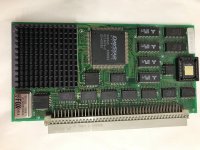Apple's development
Steve Jobs of
Apple Computer had seen the LPB-CX while negotiating for supplies of
3.5" floppy disk drives for the upcoming
Apple Macintosh computer. Meanwhile,
John Warnock had left Xerox to found
Adobe Systems in order to commercialize
PostScript and
AppleTalk in a laser printer they intended to market. Jobs was aware of Warnock's efforts, and on his return to California he started working on convincing Warnock to allow Apple to license PostScript for a new printer that Apple would sell. Negotiations between Apple and Adobe over the use of Postscript began in 1983 and an agreement was reached in December 1983, one month before Macintosh was announced.
[6] Jobs eventually arranged for Apple to buy $2.5 million in Adobe stock.
At about the same time, Jonathan Seybold (
John W. Seybold's son) introduced
Paul Brainerd to Apple, where he learned of Apple's laser printer efforts and saw the potential for a new program using the Mac's
GUI to produce PostScript output for the new printer. Arranging his own funding through a
venture capital firm, Brainerd formed
Aldus and began development of what would become
PageMaker. The VC coined the term "desktop publishing" during this time.
[7]
ReleaseThe LaserWriter was announced at Apple's annual shareholder meeting on January 23, 1985,
[8] the same day Aldus announced PageMaker.
[9] Shipments began in March 1985
[10] at the retail price of US$6,995, significantly more than the HP model. However, the LaserWriter featured
AppleTalk support that allowed the printer to be shared among as many as sixteen Macs, meaning that its per-user price could fall to under $450, far less expensive than HP's less-advanced model.
The combination of the LaserWriter, PostScript, PageMaker and the Mac's GUI and built-in AppleTalk networking would ultimately transform the landscape of computer desktop publishing.
[6] At the time, Apple planned to release a suite of AppleTalk products as part of the
Macintosh Office, with the LaserWriter being only the first component.
[11]
While competing printers and their associated control languages offered some of the capabilities of PostScript, they were limited in their ability to reproduce free-form layouts (as a desktop publishing application might produce), use
outline fonts, or offer the level of detail and control over the page layout.







